Have you ever heard of gamjatang?
Gamjatang is soup made with pork neck bones and vegetables. Sizzling hot gamjatang is hearty and savory which makes it always popular at the dinner table. The soft fatty meat picked from the gaps between the bones is especially tasty. The fully cooked cabbage and bean sprouts in the stock turn soft yet retain a crispy texture. Gamjatang makes a perfect, satisfying meal when paired with a bowl of rice.
And another selling point is that the main ingredient, pork neck bones (or spine bones) is very cheap. Combined with lots of vegetables, this soup is full of nutrients.
It’s unclear how this dish got it’s name. Some of you may know that gamja in Korean is potatoes. This soup always includes a cooked potato, so is that why it’s called gamjatang? But some people say gamja refers to the delicious meat around the pork spine bones, and that’s where it got its name. It’s still controversial and no one knows the true answer.
Some of you will remember that actually I posted the recipe long time ago, in 2009! Last month I had an event with my friend Hooni Kim at his New York restaurant. He’s also the head chef there and we made dinner and collaborated on some dishes. I entertained the readers who came to the restaurant to meet me, it was wonderful to see them.
One of my readers told me she makes gamjatang from my recipe very often and she always gets compliments from her family whenever she makes it. I realized I had forgotten about my gamjatang recipe because it was posted so long ago! I said: “The video must be blurry and low quality. Can you still learn the recipe from the video?” She said: “Yes, the recipe is still good!”
When I got home that night, I went back to watch my old gamjatang video. Oh my! I could make it better now with my HD camera and more accurate measurements. It decided to remake the video with a few changes to the original recipe.
Do you want to know what’s different? I skipped buchu (asian chives) and cooking wine this time because without them, I found it still tastes so good! And I simplified some of the process when I blanch the bones. I also soak the bones only 30 minutes instead of 2 hours. What else? Yes, I added 11 cups of water instead of 10 cups of water (my old version). So I can say that my revisiting this recipe means you can make a more delicious dish in less time now. : )
Good luck with making gamjatang. I’m looking forward to meeting you someday and hearing the story about the wonderful gamjatang you made from this recipe! : )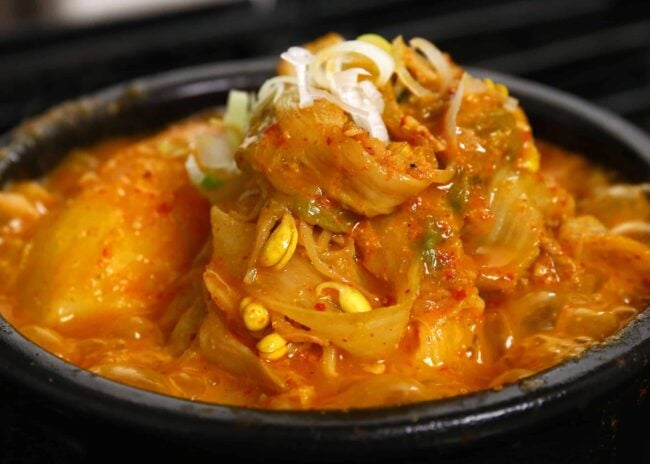
These are some tips for you if you make gamjatang tomorrow! : )
- Pork neck bones are found in the freezer section at a Korean grocery store. Try to choose bones with a lot of meat.
- My recipe is for 2 to 3 servings. If you want to make it for 4-6 servings, double the recipe and cook longer.
- Blanching and washing the bones is a very important step because it will remove the unpleasant smell from the bones and make a clear soup.
- You can replace perilla leaves with basil leaves and perilla seeds powder with sesame seeds powder.
The best perilla seeds powder to use is hulled and finely ground with a creamy color. You can also use toasted and ground, which is coarse and dark and kind of hard to swallow. Best to mix with water and strain and squeeze it, and use the water that is squeezed out in your gamjatang and discard the dregs. You can also grind whole toasted perilla seeds and then mix them with water, strain and squeeze out the milky liquid and use it. And if you can’t find any of these you can replace perilla seeds powder with sesame seeds powder.
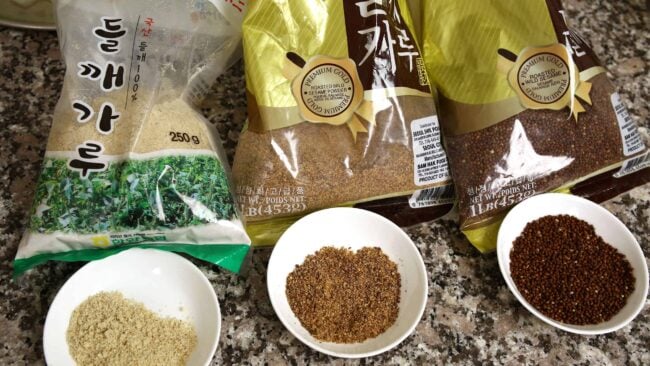 From left, skinned and ground powder, coarsely ground perilla seeds, and whole toasted perilla seeds
From left, skinned and ground powder, coarsely ground perilla seeds, and whole toasted perilla seeds
Ingredients
Makes 2-3 servings.
- 2½ to 3 pounds of pork neck bones (or spine bones)
- 1 ounce ginger, sliced
- 2 tablespoons doenjang (Korean fermented bean paste)
- 2 dried Shiitake mushrooms
- 1 medium onion, sliced
- 1 large dried red chili pepper (or a few red chili peppers)
- 1 pound of napa cabbage, cut off the core
- 2 or 3 medium potatoes, peeled
- 8 ounces soybean sprouts, washed and strained
- 4 green onions, washed and cut into 2 inch long
- 1 green onion, chopped for garnish
- 8 to 12 perilla leaves, washed
For seasoning paste:
- 6 garlic cloves, minced
- 3 tablespoons gochugaru (Korean hot pepper flakes)
- 1 tablespoon gochujang (Korean hot pepper paste)
- 3 tablespoons fish sauce
- ¼ cup deulkkae-garu (perilla seeds powder)
- ½ teaspoon ground black pepper
- ½ cup water
Directions
Cooking time: 2 hours.
Prepare the bones and broth
- Rinse the pork bones a couple of times and soak in cold water for at least 30 minutes.

- Bring a large pot of water to a boil. Blanch the cabbage for 1 minute and then take it out with tongs.
- Keep the hot water boiling, we’ll use it later for blanching pork bones.
- Rinse the cabbage in cold water and strain. Tear the leaves in lengthwise once or twice to make it long bite sized pieces.

- Put the bones into the boiling water and cover. Let them cook for 7 minutes over medium high heat. The water will turn dark and some foam will come to the surface.

- Strain the bones and wash each one in cold running water to remove any extra fat, dark foamy stuff, and bone fragments. Put the cleaned bones into a large pot.

- Add ginger, soy bean paste, dried shiitake mushrooms, onion, dried red pepper, and 11 cups of water. Cover and cook for 90 minutes over medium high heat.

While it cooks, make the seasoning paste
- Combine garlic, hot pepper flakes, hot pepper paste, fish sauce, perilla seeds powder, ground black pepper, and ¼ cup water in a bowl.
- Mix well until creamy.

Finish
- 90 minutes later, open the pot. Take out the 2 shiitake mushrooms and put them on your cutting board. Add the cabbage, soy bean sprouts, 3 green onions, and the peeled potatoes.

- Slice the mushrooms thinly and put them back to the pot. Add the seasoning paste. Add ¼ cup water and cover.


- Cook for 30 to 40 minutes over medium high heat until the potatoes are fully cooked. Test them by poking one with a chopstick or a bamboo skewer. If the chopstick goes through easily, it’s fully cooked.

- Add the perilla leaves and stir. You can serve right away with rice and a few more side dishes.

Serve
There are a few ways to serve, depending on how you like it:
- Ladle the soup into individual bowls and sprinkle each with some chopped green onion. You can also reheat the soup in earthenware bowls and then serve them to the table bubbling hot.

- Put all the soup in a large shallow pot, and sprinkle some chopped green onion over top. Put the pot in the center of the table along with the rice and some other side dishes. You can share it all together. I recommend giving out small individual bowls and a ladle so that people can put some soup in their bowl and enjoy it that way, instead of eating from the pot in the middle of the table.
Maangchi's Amazon picks for this recipe
It's always best to buy Korean items at your local Korean grocery store, but I know that's not always possible so I chose these products on Amazon that are good quality. See more about how these items were chosen.




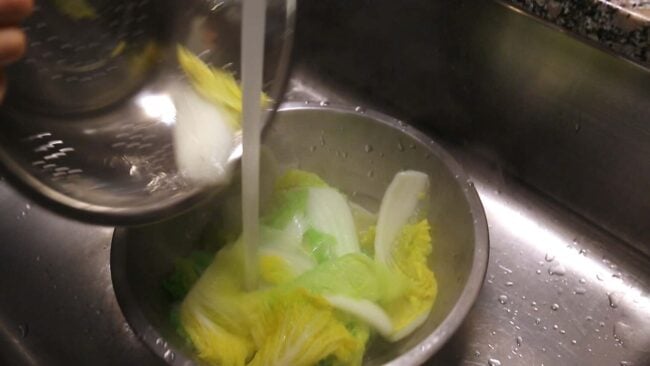
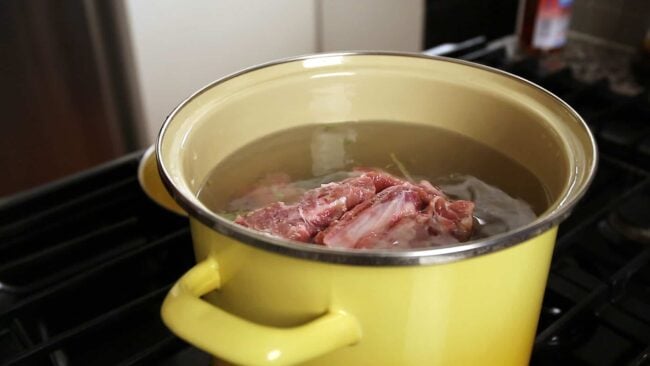
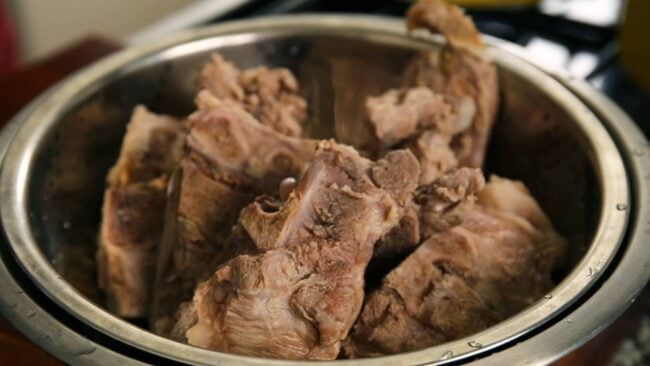
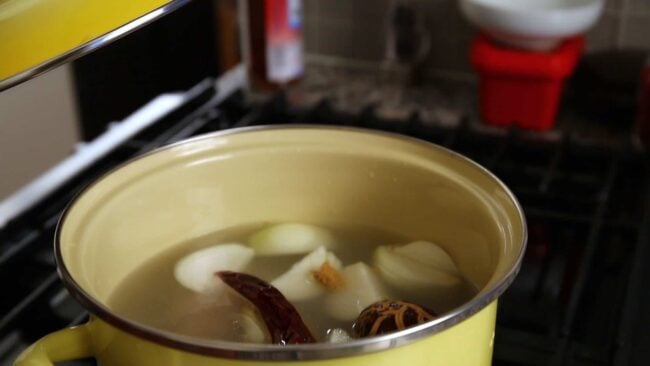
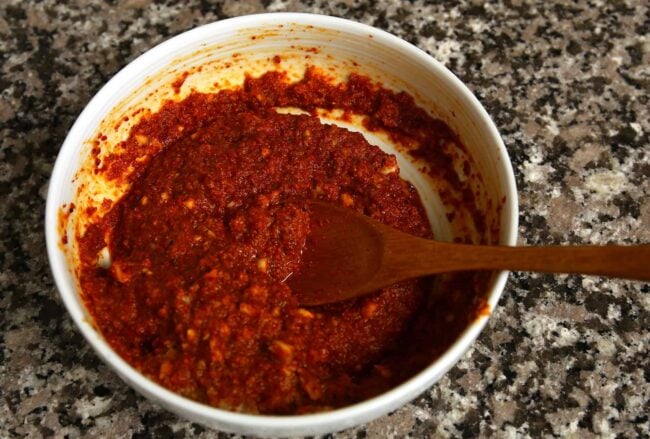
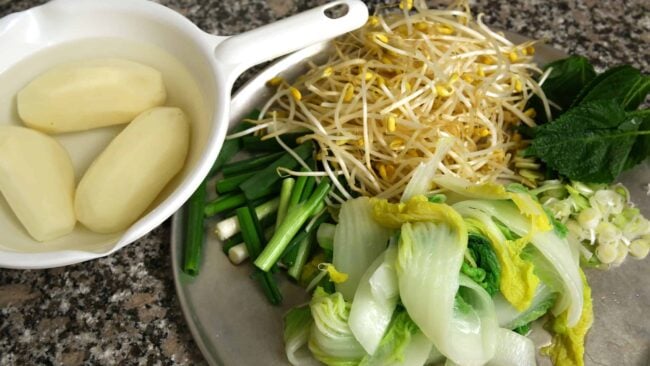
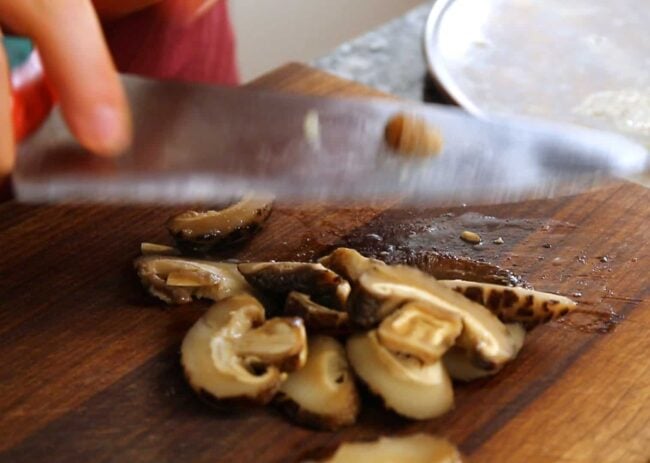
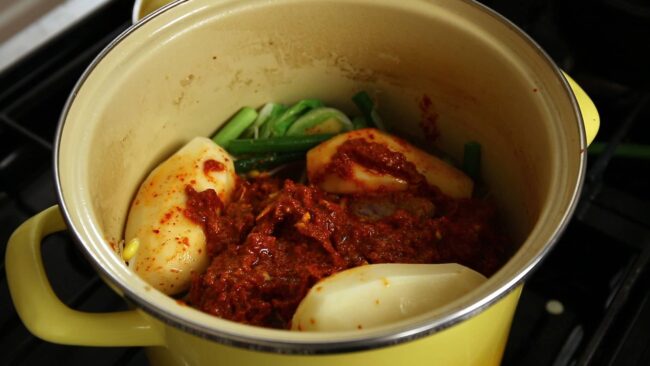
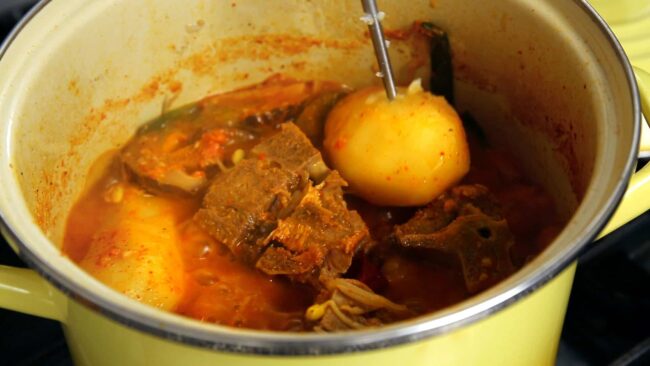
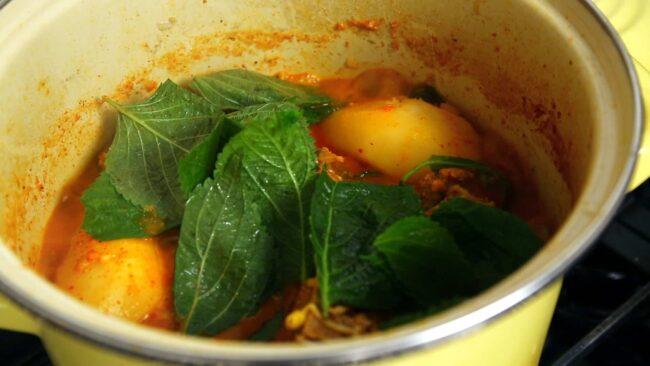












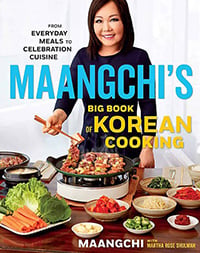




















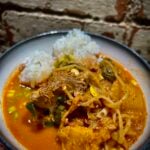
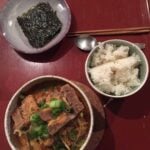
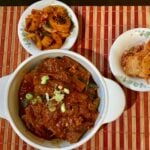
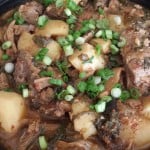
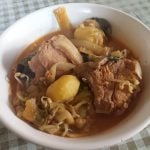
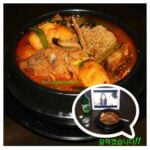
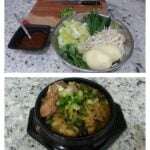
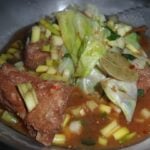

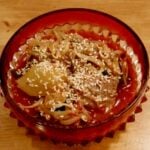
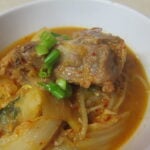

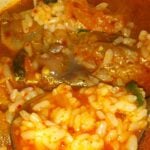
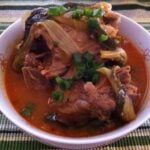
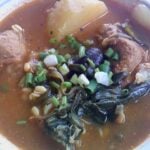
hi there! i’m a new fan of ur site and i really impressed of ur recipe..i really love kamjatang but can i ask? is the taste of neck bone diferent from the back bone coz i use to it..and what is the korean word for neck bone. As u know im from philippines and dont know what to say at meat store when i go for neck bone.i cooked sometimes and my husband and friends likes it but i never been try the neckbone.tnx and more power!!!
You could use either neck bone or back bone. I think there is not much difference in taste. I have never made gamjatang with back bone. Pork neck bone is called “doeji mokppyeo” : 돼지목뼈
Pork back pone is called “doeji deungppyeo”: 돼지등뼈
Let me know how your gamjatang turns out. Thank you!
HI, I can´t wait to make this recipe, I was living in Toronto, and i always go to korean town to eat gamjatang, Im from Mexico city, I`ve already find all the ingredients,but here the stores only sale perilla seeds, not powder What do i do, Buy them ?
You can grind the seeds finely with a coffee grinder.
I live in Toronto and love the Korean food we have available here – I am not Korean, but know what authentic Korean food is supposed to taste like from my many Korean friends…this recipe is AMAZING – it is exactly how pork-bone soup tastes in the restaurants – thank you soo much for sharing!
For those wondering, perilla plants are available for purchase during the spring/summer months. The ones I have seen and that are growing on my property are less than 2 feet tall (at most). I am hopeful that you can use typical herb-preserving methods (i.e. blanching-freezing) to preserve the leaves over the winter for additional recipes, or maybe just keep a plant indoors over the winter!
Hi Maangchi,
I love your site. Just one quick comment about the origin of the word ‘Gamjatang’: ‘Gamja’ in this case refers to a specific part of the pork’s backbone and not to a potato, which is a general misconception. If this was indeed a potato based recipe, it would be more of a kuk (국) as it would not really be considered a tang (탕). A ‘tang’ is different from a ‘kuk’ in that the broth is usually a protein (bone in) cooked for a long time, like seollongtang, gomtang, even meuntang.
Keep up the good work!
Thank you for your informative comment! Someone else mentioned the same thing somewhere on my website (or YouTube comment?) long time ago, so it made me do some research on the origin of gamjatang. Unfortunately I still don’t find clear answer about it. Check this out
http://kr.ks.yahoo.com/service/ques_reply/ques_view.html?dnum=AAL&qnum=486068
It says, there must be 2 theories regarding the origin of gamjatang. The first theory is that the name gamjatang came from the main ingredient, some part of pork spine bones called “gamjeo” in Korean,
The second theory is that gamjatang was named because it uses lots of vegetables especially potatoes. Potato is “gamja”.
Actually I don’t care much about origin of some food names or difference between tang and kuk!
Don’t give me a headache! :) I use the names my mother and grand mother, aunts, and my friends use!
AND name used all over Korea! Gamja gook is a clear brothed soup which I also enjoy where you make with some soup meat and sliced potatoes. Gamja Tang is exactly how you made it!!!! Who cares the history behind food or name!!! well…interesting to find about, but not a big deal if story telling results some difference in opinion! I LOVE your recipes! Your choice of food are not ones you find in fancy cook books(or fancy restaurants) but what you always crave because you’ve had it at home or at regular people restaurant. I am very thankful for your recipes….I feel like I have my own mom/grandma teaching me to cook ;that’s been missing in my life. I feel that most people who visit your site feel the same. We are all very grateful to your sharing these wonderful recipes. Please don’t stop!
HI
I had one question. I’m not too sure i can get the perrila seeds and leaves, what can I replace it with?
oh, just skip them.
Hi Maangchi,
I have searched for this recipe for year and have sorely missed gamja tang since leaving Korea. I would eat at least once a week when I was in Gunsan. Have asked many Korean friends for a recipe but no one knew how to cook it. I had given up looking a couple of years ago and just decided to try again. Thanks for the recipe. I look forward to cooking it soon as I can find the right ingredients.
oh, you used to live in Gunsan!
I guarantee my gamjatang recipe won’t disappoint you. : )
Hi Maangchi,
Is perilla leaves necessary? I mean how is this recipe if I cannot find perilla leaves? Can I use any substitute? Thanks
chit
You can skip perilla leaves then.
I love Gamjatang! My first taste of Korean food was in a Gamjatang restuarant. I cooked with your awesome recipe this weekend and my wife loved it so much that she ate it for dinner, breakfast and lunch!
Thanks again Maangchi ~ your recipes really help me give her some taste of home when she’s so far away from it!
You are such a cool husband! I’m very glad to hear that your wife loved your gamjatang! Gamjatang recipe is a little difficult but you made it. I think you can make any kinds of recipes I have posted so far. Cheers!
I followed you recipe and it’s AMAZING!
It is fairly long to make, but it’s well worth it! I even tried to remix it a bit by adding some fresh algae (that they sell at my local Korean market)… it was pretty good, but you got to be careful not to add to much or it will completely destroy the recipe (they quadruple in size when soaked and cooked and its taste takes a lot of place!)
But I have one question Maangchi. I have seen some pics on the web which shows this recipe to have a very deep red color (like the photo shown on wikipedia: )
Do you know what they added to make it to have this deep red tint?
Thank you in advance and thanks again for the recipe! ;)
yayee! Congratulation! Now you can make gamjatang (porkbone soup with vegetables) anytime!
The degree of redness depends on the amount of hot pepper flakes.
hello!
i tried your gamjatang today and the result was great. thanks for the wonderful recipe. this taste much better than my not so successful soon dubu jigae. :)
Congratulation on your successful gamjatang making!
hello maangchi!
i am a new fan!! i tried this dish last week and i think my husband fell in love with me all over again. he asked me if i could make it once a week for him.
thank u!!!
anna
cool cool ! : )
My husband has been craving gamja tang for months… I didn’t know how to make it. when I found this recipe, I tried it and it was absolutely fabulous! My husband thought it was delicious. This recipe is definitely a keeper. He’s asking when I will be making it again. Thanks for your awesome recipe!
Good news! Thank you for letting me know that your gamjatang turned out great!
Thanks for another great recipe Maangchi….I tried making this yesterday and it turned out really OILY with lots of fat! Any tips to fix this ? Thanks!
Did you follow the direction step by step?
“# Rinse pork neck bones in cold water and put them in boiling water with 4-5 slices of ginger (1 tbs). Cook for 7 minutes.
# Rinse and strain the pork neck bones and put them in a large pot.
*tip: when you rinse the pork bones, pick out any excessive fat”
Yup, I tried to pick out the excess fat…maybe I’m not very good at picking it out, I couldn’t find much fat on the bones!
Hi!
Try boiling the meat day before…refrigerate with the soup and you will see all the fat floating…then you can scoop them all out…then do all the rest of the recipe.
chit
Hello Maangchi! Thank you for the recipie I enjoy Gamjatang quite often just down the street, it will be great to make it on my own!
yes, homemade gamjatang can’t be compared with restaurant gamjatang in terms of taste and nutrition!
Hey. Thanks for the recipe. I am going to make this with 6 lbs of pork neck bone. Instead of about doubling the ingredients, is there anything else in particular that I should alter, such as the cooking times?
yes, you should cook longer. That’s it!
Same as Debora, I’d like to request a video of Kalbi Tang, so that I can make it myself.
It’s pricey in the resturant, consider paying $15 for a bowl which filled up with liquid(broth), only one piece of kalbi, a little bit of Dang Myun, and some egg…
ok, I will post the recipe someday. Thank you for your request!
How do you eat that whole potato?
Just use ta spoon to scoop it when eating from the earthware?
Use a spoon! : )
hi maangchi, i too just made gamjatang tonite. what a treat the final result was! my mom loved it!! i forgot to get the bean sprouts but i just substituted for more nappa cabbage instead (b/c the sprouts didn’t look fresh). though this is one of the longer recipes i’ve tried, it’s well worth all the work at the end! :)
thank you again and i can’t wait to see what else you put up! :)
p.s. kalbi tang or seollang tang would be fun to see too ;)
You made it! I would like to see what it looks like! : )
You are such a good daughter! Yes, the recipes for kalbitang and seollang tang will be posted in the future. Thank you!
oops! we ate it all before i could get a good photo… i’m making it again this sunday. i’ll send a photo then :)
This Sunday again! : )
i ate it all again! mmmm it’s so good :) i’ll try harder thsi time not to eat everything before i make it ;)
HI! I just made the gamjatang and it was EXCELLENT!!!!!! I couldnt find perilla leaves nor the powder so i didnt put them, but i did put seasame powder like you suggested to another member. I also forgot to buy the napa cabbage after two visits to the grocery store =__= So i used the white part of the chinese *bok choi* and it came out pretty well! I added some ENOKI mushroom as well…
THANK YOU, ure a genius ^^
Omg, you are very smart! Using bokchoi is a really good idea! Congratulation on your successful gamjatang making! I’m happy for you.
Thank you =) I was wondering if you thought too much flavour would be lost if I soaked the pork necks for about 12 hours – I would like to make it for dinner for someone next week, but I don’t have enough time to wait for it to soak for 2 hours before we will sit down to dinner
Thanks!
why not! You could soak it for 12 hours, but keep it in the refrigerator until you cook. Don’t worry about losing flavor, it won’t happen. Good luck with your gmajatang making!
hi maangchi,
it’s great to see that you were able to make the gamjatang! my mom has been asking me to make this for her for as long as she knew i started looking at all your recipes! i can’t wait to make some for my mom.
a couple questions,
1. what is the purpose of cooking it in a regular pot then putting it into the earthen ware bowl before serving as boiling?
2. i have noticed that restaurants use some sort of round seed… what is that?
thanks!
deborah
I’m sure you will make the most delicious gamjatang soon! : )
1,
The reason I transfer gamjatang to the earthenware bowl is to make it sizzling so that it will look more appetizing.
I think many of my blog readers bought an earthenware bowls to follow some of my recipes such as soondubu and doenjang jjigae. I should give them more chance to use their earthenware bowl as many times as possible.
If you don’t have it, you can serve it in any pot or skillet.
2.
round seed? Do the seeds look like very small balls? If so, they may be deulkkae(perilla seeds) Anyway, ground deulkkae is supposed to be used for gamjatang. If it’s not deulkkae, I don’t know.
hi maangchi,
i can’t wait! i have to do some planning though because i have to look for the deulkkae powder and seeds.
i have two sizes of earthen ware bowls! i make soon dubu for my mom every month or so. i haven’t really used it for much else though… hehehe
i think it is the perilla/deulkkae seed. it probably is more for garnish than taste though. good to know!
thank you again! i’ll be sure to send a photo your way when a good batch turns out :)
Ye!Ye!
Another Delecious Recipe Will Try It Soon
Can You Show How To Make Korean Style CURRY RICE
I Love It~~~
!!
sure, Korean style curry rice is one of my upcoming video recipes. Thank you. Let me know how your gamjatang turns out!
Is this dish really spicy? Can I make it without the spicy ingredients, such as the hot pepper flakes and paste, and the red chilli pepper? I’d prefer to make it not spicy.
You could try it out without using hot spicy ingredients. Use more soybean paste then.
This looks so good! I’ll definately have to try it sometime :)
oh i liked this soup very much when my husband was in korea
Tommorow My Husband’s Boss Is Coming Who Is Korean And His Fav Food Is Kalbi
I Know That You’ll Show Kalbi Video Someday But its Urgent
Can You Tell Recipe In Short (PLEASE)
:)
You could use the recipe for bulgogi marinade for kalbi, too!
https://www.maangchi.com/recipe/bulgogi-and-bulgogi-stew
Hi Maangchi,
Thank you for your recipe!
One question: Why a lot of people use Soy Bean Paste to make this soup? Is it necessary? Thank you for your answer!
Yes, it’s necessary for this recipe. A little amount of soy bean paste removes pork meat odor and also makes this soup delicious.
I was wondeirng, if you can use japanese miso instead of the soybean paste. Would it taste very different? Thanks
yes,it will be good, too!
Hi!
Wow, that looks really tasty!
I’ve never been able to find perilla leaves at my korean grocer, so its good to know that basil might work as well.
I was just wondering what the purpose of soaking the pork bones in water is?
Thanks for the new recipe-
Oh, and i love the new layout for your website- très cool.
oh, the reason for soaking pork bones is to get rid of blood that has some odor.
Hi..Kam Ja Tang was one of my favorite meals on a cold winter day. It is so delicious. I’m going to try this recipe for sure! I think it’s odd that it is called “potato soup”. There’s really a lot more meat than spuds!
Thanks for all the recipes and cooking demonstrations on youtube.
You are very welcome! Make delicious gamjatang!
Thanks for the recipe! Is it possible to make this recipe with beef? If you can,what part of beef can you use? (my husband doesn’t like pork)
I’ve been wanting to eat 감자탕 ever since 감자탕 전문 식당 opened up in Flushing. By the way, I’ll be making 화전 for my mother-in-law for Mother’s Day. Thanks a lot! 좋은 주말 보내시길 바래요. ^_^
I think you could replace pork bones with beef short ribs. Let me know how it turns out if you make it.
Hi Maangchi! Have you heard back about whether 감자탕 would taste good with beef short ribs? 저는 되지를 못먹어요. I have allergies to pig, so I wanted to know how it would taste. I never had 감자탕 made for me due to my allergies. Please let me know! 고마워요!
: ) beef short ribs for this recipe sounds good! I should try it out, too. Thank you very much for your question.
Hi Maangchi,
Can you upload the podcast? Bcuz u prefer to cook and watch the video at the same time…
=) thank you!
I am doing it now! : )
Maangchi,
I just recently stumble into your blog.
I love your informative blog and video too.
This soup looks very hearty. H Mart just recently opened in my neighborhood and they have great selection of everything Korean :-)
I should try some of your recipe.
oh, you are lucky to have a Korean grocery in your neighborhood!
Some of my blog readers drive hours and hours to get ingredients.
It sounds like you will become a regular customer of the store.
So yummy yummy!
If only I have a korean market nearby my house…My asian market never sell perilla leaves and perilla seed powder.
hmmm, sorry to hear that. How about replacing perilla leaves with basil leaves. Use just a little bit. And instead of perillar seeds powder, use sesame seeds powder. If sesame seeds powder is not available, just skip it. Modify the recipe adjusting to your situation. Let me know how it turns out if you make it. I’m curious.
I just tried it out and substituted with basil and sesame seeds as you suggested. I also used beef bones and a brisket, instead. I have to say it turned out better than I could imagine! I’ll send you a pic when I upload it. Thank you for the tip and many inpirational videos.
ryan,
you are so smart! : )
Hi – I thought that I’d point out that sometimes the powder will be labelled as “frutescens powder” (latin name). That’s how it is at my local market, but it’s the same thing!
I’ve never had this, it looks delicious.